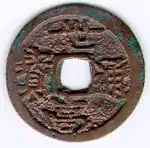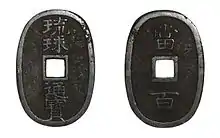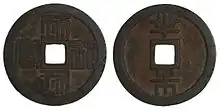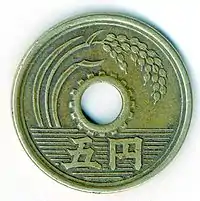Ryukyuan mon
The Ryukyuan mon (琉球文, Ryūkyū mon, Okinawan: Ruuchuu mun) was the currency of the Ryukyu Kingdom from 1454 to 1879, when the kingdom was annexed by the Empire of Japan and the currency was replaced by the Japanese yen. The Chinese character for mon is 文, which was widely used in the Chinese-character cultural sphere, e.g. Chinese wén, Vietnamese văn, and Korean mun. The Ryukyuans produced their own coins until the 15th century, but became dependent on Chinese coins until the 19th century when they briefly minted their own coins again. From 1862 the minting was outsourced to Kagoshima City, Satsuma Domain and were based on the Japanese mon (specifically on the "Kan'ei Tsūhō" copper coins). All of the Kagoshima-minted coins bear the phrase "Ryūkyū Tsūhō" (琉球通寳) (circulating treasure of Ryukyu); this phrase was written in Seal script on the half shu (248 mon) coin.[1] Despite the annexation of the Ryukyu Kingdom in 1879, these coins continued to circulate within Okinawa Prefecture well into the 1880s as the Ryukyuans were initially unwilling to use Japanese yen coins.
| Ryukyuan mon | |
|---|---|
| 琉球文 | |
 A Sekō Tsūhō (世高通寳) cash coin. | |
| Denominations | |
| Superunit | |
| 496 | Shu (朱) |
| 7936 | Ryō (両) |
| Demographics | |
| Date of introduction | 1454 |
| Official user(s) | Ryukyu Kingdom |
| Unofficial user(s) | |
| Valuation | |
| Pegged with | |
This infobox shows the latest status before this currency was rendered obsolete. | |
History
The first Ryukyuan coins to circulate were the Taise Tsūhō (大世通寳) in 1454 under the reign of King Shō Taikyū;[2] the second were the Sekō Tsūhō (世高通寳) which were first minted in 1461 under the reign of King Shō Toku. Though the Taise Tsūhō are considered the oldest Ryukyuan coins, there are possibilities that an older version of the Chūzan Tsūhō (中山通寳) was cast between 1321 and 1395 by the Kingdom of Chūzan, though these possible coins should not be confused with a later Chūzan Tsūhō cast under King Shō Kō. Both the Taise Tsūhō and Sekō Tsūhō were modelled after the Ming dynasty Eiraku Tsūhō (永樂通寳), a coin manufactured en masse for foreign trade. Because copper shrinks when it cools, the Sekō Tsūhō was smaller than the Chinese Eiraku Tsūhō. The Sekō Tsūhō was originally cast to make up for a shortage of currency often attributed to reckless politics and high government expenditure, such as the expensive invasion of Kikai Island by King Shō Toku in the 1460s.[3]
Coins issued by the Ryukyu Kingdom:[4][5]
| Inscription | Kyūjitai | Shinjitai | King | Dynasty | Image |
|---|---|---|---|---|---|
| Taise Tsūhō | 大世通寳 | 大世通宝 | Shō Taikyū | First Shō |  |
| Sekō Tsūhō | 世高通寳 | 世高通宝 | Shō Toku | First Shō |  |
| Kin'en Sehō | 金圓世寳 | 金円世宝 | Shō En | Second Shō | |
| Chūzan Tsūhō | 中山通寳 | 中山通宝 | Shō Kō | Second Shō |
Despite the small size of the Ryukyu Kingdom, the coins from this era are not uncommon (with the notable exception of the Kin'en Sehō and Chūzan Tsūhō coins)[6] and have been known to be regularly found on the Indonesian islands of Java and Sumatra due to the international nature of these coins and the success of Ryukyuan maritime trade.[7] After the issuance of the Kin'en Sehō in 1470, the Ryukyu Kingdom stopped manufacturing their own mon coins and imported Chinese currency as the main medium of exchange.
As no official records exist of the production of these coins it is sometimes taken into doubt that these coins were actually produced by the Ryukyu Kingdom.[8]
Denominations after 1862
100 mon (琉球通寳 – 當百)

The 100 mon Ryūkyū Tsūhō (琉球通寳) coin was an ellipse-shaped coin modeled after the Japanese Tenpō Tsūhō (天保通寳) coin of the same denomination. Like the Tenpō Tsūhō, its face value was placed at 100 mon but its weight was merely 6 to 7 times that of a 1 mon coin. Despite this, Satsuma Domain ordered that it would circulate at the value of 124 mon, which made it a profitable coin to manufacture, but this made the coin unpopular in circulation.
The 100 mon was first manufactured by the government of Satsuma in Kagoshima City from 1862 for circulation within the Ryukyu Islands as well as in the Satsuma Domain itself, but started to circulate in Japan's other provinces soon after their production. Coins minted in Kagoshima bear the mark of the katakana character "sa" (サ) on the left and right flat edges of the observe, which signifies that the coin is from Satsuma Domain.[9]
Half Shu (琉球通寳 – 半朱)

The half Shu (半朱) denomination was a round coin with a square hole introduced alongside the 100 mon by Satsuma, which ordered it to circulate at the value of 248 mon despite it weighing only 10 to 12 times the weight of a single mon coin. The word Shu (朱) is a Japanese unit of measurement used with gold currency, indicating that the Satsuma government was trying to fix the exchange rate between the copper mon coins and gold currency such as the Koban. Officially, one half Shu would mean 32 coins would have the value of one Ryō (両), though this conversion rate seems unlikely to have occurred in practice.[10] The production of these coins was set up by Daimyō Shimazu Nariakira in order to rebuild Satsuma's economy; in total, around one million Ryō worth of Ryukyuan coins were minted from 1862 to 1865.[11][12]
See also
References
- "Ryuukyuuan coins". Luke Roberts at the Department of History - University of California at Santa Barbara. 24 October 2003. Retrieved 1 June 2017.
- "Taise Tsūhō", (in Japanese) Okinawa Compact Encyclopedia 沖縄コンパクト事典, Ryūkyū Shimpō, 1 March 2003. Access date = 8 June 2017.
- 九州歴史資料館 (Kyūshū Historical Museum) 「大世通宝・「世高通宝」は 琉球王国が発行したコイン .] (in Japanese) Retrieved: 9 June 2017.
- JUGEMテーマ:地域/ローカル 琉球王国に貨幣はあったのか?琉球王国の通貨 (in Japanese.) Date: 23 April 2013. Retrieved: 9 June 2017.
- 琉球王国大世主尚圓王。 金圓世寳 (in Japanese) Retrieved: 9 June 2017.
- Cocolog 雑記@史華堂 「中山通宝」について。 (in Japanese) Published: 8 February 2013 Retrieved: 9 June 2017.
- (日本銀行), Nippon/Nihon Ginkō (1973). "p. 105". Nihon Ginkou Chousakyoku ed., Zuroku Nihon no kahei, vol.1 (Tokyo: Touyou Keizai Shinpousha, 1973). Tokyo: Nihon Ginkō. Chōsakyoku. / Bank of Japan, Economic Research Department.
- The British Museum - Catalogue of the Japanese Coin Collection (pre-Meiji) at the British Museum with special reference to Kutsuki Masatsuna by Shin’ichi Sakuraki, Helen Wang and Peter Kornicki, with Nobuhisa Furuta, Timon Screech, and Joe Cribb. ISBN 978 086159 174 9 ISSN 1747-3640 (© Copyright the Trustees of the British Museum 2010) Retrieved: 11 April 2018.
- "Japanese Coins Circulating on Perry's Arrival and Shortly Thereafter in the Ryukyu Kingdom". George C. Baxley (Baxley Stamps). Retrieved 1 June 2017.
- (日本銀行), Nippon/Nihon Ginkō (1973). "pp. 319-322". Nihon Ginkou Chousakyoku ed., Zuroku Nihon no kahei, vol.1 (Tokyo: Touyou Keizai Shinpousha, 1973). Tokyo: Nihon Ginkō. Chōsakyoku. / Bank of Japan, Economic Research Department.
- Ryūkyū Tsūhō (in Japanese) Okinawa Compact Encyclopedia, 沖縄コンパクト事典, Ryūkyū Shimpō, 1 March 2003. Access date = 8 June 2017.
- Robert Hellyer, Defining Engagement, Harvard University Press (2009), 192.
| Wikimedia Commons has media related to Coins of the Ryukyu Kingdom. |
| Preceded by: Chinese wén Reason: Local production. |
Currency of the Ryūkyū islands 1454 – 1879 |
Succeeded by: Japanese yen Reason: Annexed by Japan. Ratio: 10.000 mon = 1 yen |
.jpg.webp)
